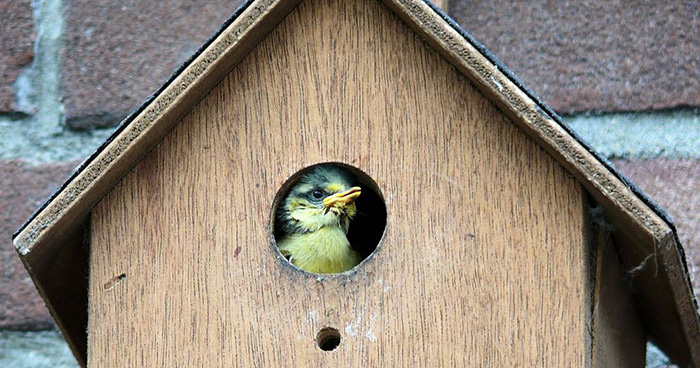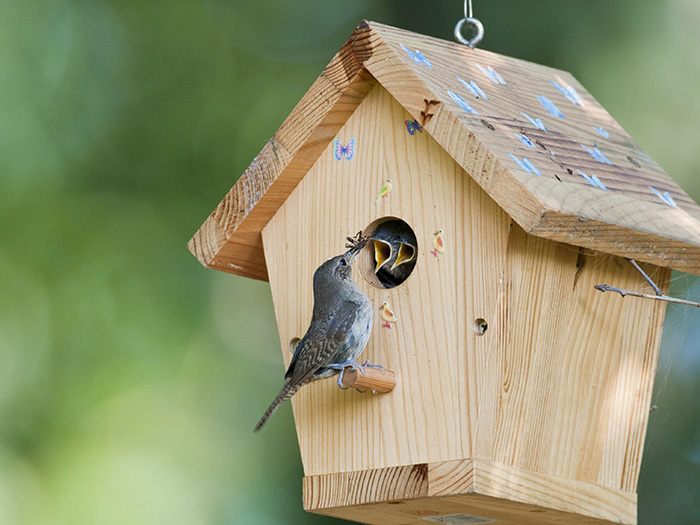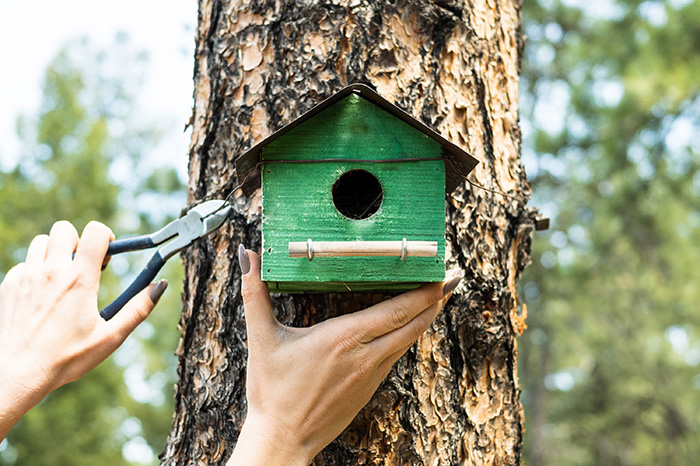If your birdhouse doesn’t have any sort of drainage system, it’s a design error that needs fixing to ensure the safety of the birds nesting inside.
Birdhouses require drainage holes to allow rainwater to escape through the base. A birdhouse’s entrance hole and any unsealed gaps on the joints are fair game for rain water. Don’t fill these holes in, but if you need to, you can drill more drainage holes into the base.
You are reading: Inside Birdhouses Do Need Drainage

A birdhouse’s foundation should have multiple holes drilled into it, as this is arguably one of the most important components.
Water from rain or condensation inside the birdhouse will naturally drain through the holes in the bottom.
Horizontal rain is the most common type of precipitation to penetrate a birdhouse, and the entrance hole serves as the primary site of entry for this type of precipitation.
Amazingly, drainage holes in birdhouses also serve as important ventilation openings, letting moisture leave while allowing air to circulate inside the box.
All of these features make for a cozier nesting and brooding space for birds throughout the warmer months.
Without these easy to install predrilled holes, water can collect within a birdhouse, causing the young to drown or the parents to abandon the nest.
Birdhouses do need drainage
A birdhouse is only suitable for housing birds if the birds are able to nest and raise their young in a box made of wood.
As a result, birdhouses require drainage, as there is a high probability that water will find its way into the structure.
The most significant problem is rain water, which can enter the house through the entrance hole when the wind is blowing sideways. However, no birdhouse design can be guaranteed to be completely watertight. There is a serious risk that rainwater will collect in the container.
Drilling drainage holes into the bottom of a bird house is an important step regardless of the species being housed.
The good news is that the nesting birds and their young are safe and unaffected by the holes you drill into the bottom of their birdhouse.
For any possible water accumulation, the drainage holes will let it escape via the bottom.
Drainage holes in a birdhouse also serve an important ventilation function.
Drainage, air vent combination

A birdhouse that has proper drainage is both a need and a mark of construction quality.
In addition to their practicality, the ventilation holes cut into the birdhouse’s wooden structure allow air to circulate and keep the birds healthy.
Birdhouses can grow warm in the spring and summer, and they can get damp in the winter due to condensation, so they need many of ventilation holes to be comfortable for nesting birds year-round.
While drilling up to four holes in the birdhouse’s foundation is necessary for water drainage, it’s not nearly enough to provide for adequate air circulation within.
The entrance hole in a birdhouse lets air circulate through the structure, whether it is at ground level or above, providing welcome ventilation.
Unintentional gaps in the birdhouse’s construction, typically on the roof portion or at the corners where the birdhouse wall is joined with nails or screws, can also be used to aid drainage holes with a vent combination.
The airflow around a birdhouse’s openings is essential to the bird’s survival, therefore you should never try to block it off.
Moisture build up possible
Condensation can cause a birdhouse to get damp in the summer, when the temperature is already high from a nesting pair of birds and any eggs or young they may have.
As a result, it’s not out of the question for the birdhouse’s interior to get damp on the inside walls or bottom panel of wood if enough moisture is introduced.
Even though I don’t think it’s conceivable that a birdhouse will ever become too damp for birds to dwell in, it’s important to make sure that any moisture can escape through the drainage holes in the base and that the house is well ventilated.
Water becomes evident through flowing drips on well treated birdhouses in preserve, but it cannot sink into the wood because of the waterproof shine.
To prevent the moisture from not drying and causing a hazardous consumption that the young would consume, I won’t discourage you from painting, treating, or staining the interior of the birdhouse if necessary.
Keep the birdhouse in good condition by drilling more drainage holes if necessary to improve air circulation.
That’s why it’s important to remember to never make any openings in the roof or sides of the birdhouse.
Avoid blocking holes

Read more : 10 Colorful Types Of Rainforest Birds
Unfortunately, it is possible for these drainage holes to become blocked by natural nesting material added to the birdhouse as birds set up their home.
The first step in any nesting material is a plush cushion, which can determine whether or not any holes are concealed. However, because this and the subsequent nesting material added on top is usually soft, water or moisture should still be able to drop to the base.
You should never add more stuff to a birdhouse if it would hide the holes you bored at the bottom.
Because wood chippings can consolidate and harden into an obstruction, it’s important to keep in mind that they might cause problems.
Birdhouses designed specifically for bluebirds have special features, such as raised grills, to prevent nesting material from reaching the base.
The end result is that no nesting material — yours or the bird’s — will be able to obstruct the holes in the bottom of the box.
This has the added benefit of allowing air to continue to circulate around the space, supposing any openings for ventilation haven’t been blocked off.
To conclude
It is essential that any birdhouse you wish to install in your yard have a series of predrilled holes exclusively on the bottom of the birdhouse.
Be sure the birdhouse you bought has pre-drilled holes, but don’t worry if it doesn’t if you or someone you know is handy with DIY projects.
Rain may only flow downwards, so drains must be positioned at the bottom.
Four to six holes, up to half an inch in diameter, punched into the birdhouse’s roof provide adequate airflow.
Due to their dual function as drainage and ventilation openings, it is crucial that they remain unblocked at all times.
A birdhouse’s entrance hole, and any cracks or crevices that aren’t sealed, are all potential entry points for rain water. Side joints on birdhouses should not be sealed, as this is part of what helps to keep the house cool in the summer.
Even in the dead of winter, condensation can form, but a predrilled drainage hole, air vent hole combination, and entrance hole with any gaps all work together to keep the box dry and comfortable for the birds to inhabit for weeks at a time.
Natural nesting material brought in by birds will not help if the drainage holes become clogged, thus you should never add your own wood chippings to a birdhouse.
When it rains or becomes damp inside a birdhouse, the water has to go somewhere.
Source: https://petstutorial.com
Category: Birds










